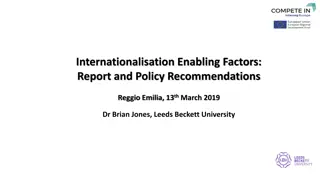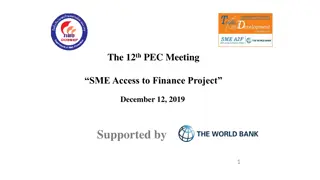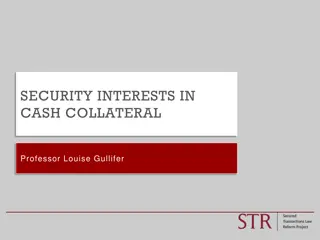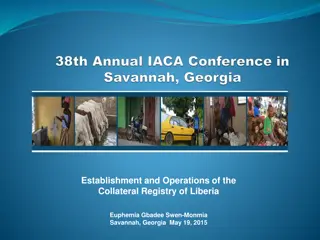Exploring Collateral Laws in SME Finance for Economic Growth
Analyzing the impact of collateral laws on SME finance and sectoral activity, Calomiris et al.'s paper discusses the significance of movable versus immovable collateral and the potential distortions in economic and financial activities. The study evaluates the role of governmental intervention and explores additional factors like reverse causality and mitigating solutions such as leasing and technological innovations in shaping lending practices. The paper raises questions regarding the necessity of SME financing for overall economic growth and highlights the challenges in addressing the financing needs of SMEs.
Download Presentation

Please find below an Image/Link to download the presentation.
The content on the website is provided AS IS for your information and personal use only. It may not be sold, licensed, or shared on other websites without obtaining consent from the author. Download presentation by click this link. If you encounter any issues during the download, it is possible that the publisher has removed the file from their server.
E N D
Presentation Transcript
Promoting SME Finance: When and How? Comments on How Collateral Laws Shape Lending and Sectoral Activity by Charles Calomiris, Mauricio Larrain, Jose Liberti, Jason Sturgess Discussion by Sergio Schmukler Finance and Development Conference November 2, 2016 World Bank Washington, DC
Two difficult tasks Comment on a great paper, already accepted for publication Discuss broad issue of SME finance posed by the session Does fostering SME finance matter for economic growth? What works and what does not work in fostering SME finance? The role of the government in promoting SME finance Do all this in about 10 minutes And provide comments to own co-authors
Calomiris et al. paper Need of collateral for lending Movable vs. immovable collateral Weak laws hamper use of movable collateral & might tilt production toward immovable-intensive sector Contribution Great paper Several pieces of evidence, including financial and real activity Proprietary bank data in 12 emerging economies Case study of Slovakia Sectoral data Innovative and persuasive, tackling main issues Need for this kind of research, which adds to cumulative evidence Still leaves questions for further research
Calomiris et al. paper More obvious points, some already addressed Omitted factors Reverse causality, endogeneity of collateral laws Conclusions: distortions in financial and economic activity? Other effects besides LTV How firms use more finance Effects on immovable collateral Mitigating factors Leasing, technological innovations (blocking devices), financial innovations (bitcoin), formal solutions (NAFIN), informal solutions Might make movable collateral laws less relevant Effects of collateral laws vs. other laws
Does more SME finance matter for economic growth? Would need to answer at least three challenging questions 1. Do SMEs need more financing? 2. If SMEs receive more financing, do they grow more? 3. If SMEs grow more, how much do they matter for overall growth? Difficult to address even the first question Fact: SMEs borrow less and in worse terms than other firms Due to problems in supply- or demand-side of capital? If supply-side problem, which one? Many possible, concurrent answers, with unclear relative importance Better off intervening?
What works and not in fostering SME finance? Big push to provide more financing to SMEs Based on Evidence of SMEs not getting good finance Probable, real problem of access to finance for SMEs But even if there is a problem, of which type of financing is needed? Just more? Lower cost? Equity? Long-term debt? Solution depends on How risks get mitigated How risks get redistributed: creditors vs. debtors Even if more financing pushed, not clear what SMEs would do with it Don t know this even for large corporations
Role of the government Do more than providing good macro and institutional environment? Even under market failures, can government failures be avoided? General principles Identify binding constraints Crowd in private sector Work closely with private sector Still Which instruments/policy should be used? Which institutions should conduct interventions?
Role of the government Policy Type of policy Contractual-based measures Information-based measures Example Calomiris et al. Credit bureaus Verdict Market infrastructure NAFIN, Mexico Catalytic role FIRA, Mexico Public guarantees FOGAPE, Chile ? Direct lending Public banks: retail and wholesale ?
Role of the government Institution Type of institution Ministry of Finance/Economy Central bank Example of interventions Subsidies Regulations, bureaus Verdict ? ? Superintendencies SME programs ? Public banks From traditional to innovative World Bank, IADB, CAF: loans, guarantees, others ? International organizations ?























